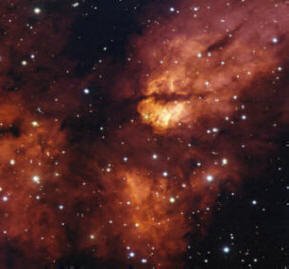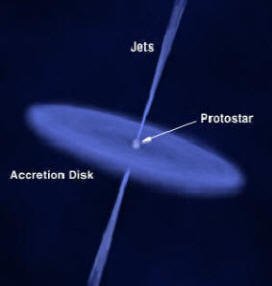Nebula is the birthplace of stars -- Part 1 to Part 6
A nebula is a cloud of dust formed by certain conditions, most of which are bursts or star residues that have exploded as a result of a disruption in their operations, including the life of the star and the end of his life.
The nebula is the basic building blocks of the universe. It contains elements from which stars and solar systems derive. It is also one of the most beautiful objects in the universe, glowing and twirling with a wonderful blend of reflective colors from the stars' lights within these clouds that make them glow in beautiful red, blue and green colors of different elements within the nebula.
More toxicity is about 90% hydrogen, about 10% helium and 0.1% of various heavy elements such as carbon, nitrogen, magnesium, potassium, calcium and iron.
The cloud of that material is very large, and in fact, it is among the largest objects in the galaxy. Many of them extend to tens or hundreds of light years

Nebula is the birthplace of stars
Sediment is often the birth area of the stars. In these areas there are large formations of gas, dust and other materials that come together to form larger blocks, which in turn start to attract more material scattered in the mist, and eventually become massive enough to form a star or more , The massive stars form in the center of the nebula, and can be seen as a result of ionizing the surrounding gas by the effect of ultraviolet light, which helps to make it visible in light waves, and take the new stars in the formation and then called young stars or emerging, forming a free star assembly. And the rest of the material is believed to be the formation of planets and other bodies of the planetary system

The material then begins to cluster in groups and grow in size. As they increase their attractiveness, gravity continues to pull the material out of the nebula until one or more clusters reach a critical mass. Protostars - an early stage of star formation - can continue to star in the same mass of the sun for about 100,000 years - and as gravitational attraction continues more intensively, a shift of gravity to thermodynamic energy, which increases cloud heat .
As the cloud shrinks as the temperature increases, and continues to increase in the center to 18 million degrees, at this point begins a nuclear fission and generates the star. The star wind from the generated star will push all the excess dust and gas out. The formation of smaller clusters of matter surrounding the star may form planets. This is the beginning of a new solar system
The shape of the mist
Scientists believe that there are two different origins of the presence of nebula in the universe. The first is due to the material created by the process of creating the universe itself. Shortly after its birth, the atoms in the universe formed the first dust and gas withdrawal, which means that the gas and dust that form in this type of nebula did not originate from the stars, but it is the original material from the beginnings of the universe. .
The second is the result of the explosion and death of the stars, for example Supernova explosion of giant stars, which occur as a result of the death of short-lived stars are huge stars, where the explosion of supernova materials around it, and where ionizing the substance of the impact of energy that can produce and the This explosion.
One of the best examples of this is Crab Nebula Crab nebula in Taurus, the Supernova event was recorded in 1054 and is called SN 1054, and the culprit that is the result of this event located in the center of the nebula is a neutron star. Or may be formed by the death of a low-mass star such as our sun. Where stars that have a mass of up to 8 to 10 solar blocks evolve into red giants at the end of their lives and slowly lose their outer layers during pulses in their atmosphere. When the star loses enough material, its temperature can rise and UV radiation is emitted to ionize the surrounding nebula, which the star itself gave. This form of hydrogen is mainly composed of hydrogen, which accounts for about 97% and about 3% of helium in addition to small quantities of other elements.
But those theories about the origins of nebulae are not clear or there is a study confirming or returning a specific method, and the nebula can be a mixture of the primitive material left from the creation of the universe as well as new substances resulting from the death of stars
Nebula is the birthplace of stars -- Part 1 The Post has been added
Planetary Nebula -- Part 2
Emission Nebula -- Part 3
Reflection Nebula -- Part 4
Dark Nebula -- Part 5
Supernova Remnants -- Part 6
We can think of Steemit as our Nebula, its birthing quite a few writers and thinkers
Great article
Intresting post this one, i didnt knew a bunch of things about nebulas, i mean, i did know that exixts, but for example, i didnt knew how they born, very educative, keep it like this!!